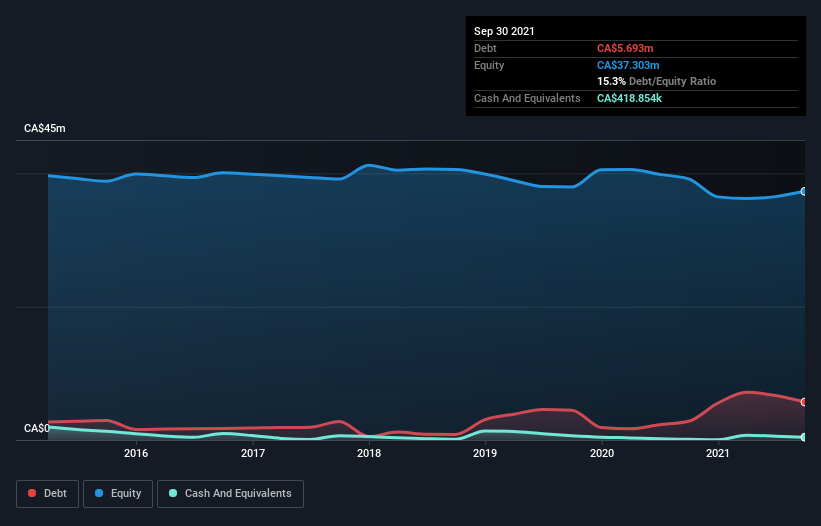Warren Buffett famously said, 'Volatility is far from synonymous with risk.' So it might be obvious that you need to consider debt, when you think about how risky any given stock is, because too much debt can sink a company. We note that Oceanic Iron Ore Corp. (CVE:FEO) does have debt on its balance sheet. But the more important question is: how much risk is that debt creating?
Why Does Debt Bring Risk?
Debt is a tool to help businesses grow, but if a business is incapable of paying off its lenders, then it exists at their mercy. Ultimately, if the company can't fulfill its legal obligations to repay debt, shareholders could walk away with nothing. However, a more frequent (but still costly) occurrence is where a company must issue shares at bargain-basement prices, permanently diluting shareholders, just to shore up its balance sheet. Having said that, the most common situation is where a company manages its debt reasonably well - and to its own advantage. The first step when considering a company's debt levels is to consider its cash and debt together.
View our latest analysis for Oceanic Iron Ore
What Is Oceanic Iron Ore's Net Debt?
You can click the graphic below for the historical numbers, but it shows that as of September 2021 Oceanic Iron Ore had CA$5.69m of debt, an increase on CA$2.81m, over one year. However, it also had CA$418.9k in cash, and so its net debt is CA$5.27m.

How Strong Is Oceanic Iron Ore's Balance Sheet?
According to the last reported balance sheet, Oceanic Iron Ore had liabilities of CA$759.3k due within 12 months, and liabilities of CA$6.19m due beyond 12 months. Offsetting these obligations, it had cash of CA$418.9k as well as receivables valued at CA$8.4k due within 12 months. So its liabilities total CA$6.52m more than the combination of its cash and short-term receivables.
This deficit is considerable relative to its market capitalization of CA$9.18m, so it does suggest shareholders should keep an eye on Oceanic Iron Ore's use of debt. This suggests shareholders would be heavily diluted if the company needed to shore up its balance sheet in a hurry. When analysing debt levels, the balance sheet is the obvious place to start. But it is Oceanic Iron Ore's earnings that will influence how the balance sheet holds up in the future. So if you're keen to discover more about its earnings, it might be worth checking out this graph of its long term earnings trend.
Given its lack of meaningful operating revenue, investors are probably hoping that Oceanic Iron Ore finds some valuable resources, before it runs out of money.
Caveat Emptor
Importantly, Oceanic Iron Ore had an earnings before interest and tax (EBIT) loss over the last year. Indeed, it lost CA$637k at the EBIT level. Considering that alongside the liabilities mentioned above does not give us much confidence that company should be using so much debt. Quite frankly we think the balance sheet is far from match-fit, although it could be improved with time. However, it doesn't help that it burned through CA$905k of cash over the last year. So in short it's a really risky stock. When analysing debt levels, the balance sheet is the obvious place to start. However, not all investment risk resides within the balance sheet - far from it. Be aware that Oceanic Iron Ore is showing 6 warning signs in our investment analysis , and 4 of those can't be ignored...
Of course, if you're the type of investor who prefers buying stocks without the burden of debt, then don't hesitate to discover our exclusive list of net cash growth stocks, today.
New: AI Stock Screener & Alerts
Our new AI Stock Screener scans the market every day to uncover opportunities.
• Dividend Powerhouses (3%+ Yield)
• Undervalued Small Caps with Insider Buying
• High growth Tech and AI Companies
Or build your own from over 50 metrics.
Have feedback on this article? Concerned about the content? Get in touch with us directly. Alternatively, email editorial-team (at) simplywallst.com.
This article by Simply Wall St is general in nature. We provide commentary based on historical data and analyst forecasts only using an unbiased methodology and our articles are not intended to be financial advice. It does not constitute a recommendation to buy or sell any stock, and does not take account of your objectives, or your financial situation. We aim to bring you long-term focused analysis driven by fundamental data. Note that our analysis may not factor in the latest price-sensitive company announcements or qualitative material. Simply Wall St has no position in any stocks mentioned.
About TSXV:FEO
Oceanic Iron Ore
An exploration stage company, engages in the acquisition and exploration of iron ore properties in Québec, Canada.
Medium-low risk with imperfect balance sheet.
Market Insights
Community Narratives


Recently Updated Narratives

Early mover in a fast growing industry. Likely to experience share price volatility as they scale


Near zero debt, Japan centric focus provides future growth

TAV Havalimanlari Holding will fly high with 25.68% revenue growth
Popular Narratives


MicroVision will explode future revenue by 380.37% with a vision towards success


The company that turned a verb into a global necessity and basically runs the modern internet, digital ads, smartphones, maps, and AI.



